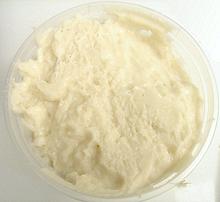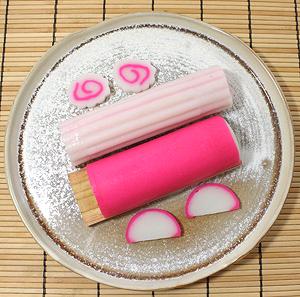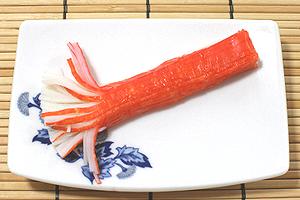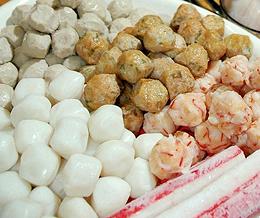
The products on this page are made from Surimi, which is non-oily white fleshed fish that has been deboned and ground to paste (photo at left). Most commonly it is Alaskan Pollock, but in Japan Daggertooth pike conger is also much used. Other fish, such as Golden Threadfin Bream are used in particular regions. photo by Sjschen distributed under license Creative Commons Attribution Share-Alike v3.0 Unported.
Surimi is also a basic ingredient made commercially and at home, used to
make fish patties, crab patties, and other cooked products. These are too
diverse to be included here, but a few appear in our recipes sections.
 [Kamaboko (Japan); Eomuk (Korea)]
[Kamaboko (Japan); Eomuk (Korea)]
In the photo to the left are shown the two most common forms of Fish Cake in Japan. The Red Kamaboko is also made in all white Shiro Kamaboko. The spiral form shown above it is Narutomaki. Both of these were made in USA from Alaskan Pollock.
These forms are molded from Surimi (see at top), then steamed to make then
set into a solid form. Kamoboko is use as purchased, as an Appetizer, a
Topping for Miso Soup, in a Salad, and other similar uses. It is also chopped
up and combined with other ingredients to make Kamaboko Dip, quite popular in
Hawaii.
 Fish Cake is available in a number of fried forms, including small cubes and
rectangles. Two forms are pictured here.
Fish Cake is available in a number of fried forms, including small cubes and
rectangles. Two forms are pictured here.
Thin flat sheets, made in USA for the Korean market. They were 6 x 5 x 0.16 inches (15 x 13 cm x 4 mm). They are sliced for use in stir fries and other dishes. They are also sold unfried, but my Korean market didn't have those. Made from Alaska Pollock and/or Cutlassfish and/or .....
Thick cake (Oban Age) made in Japan, 4-3/4 x 3-1/2 x 0.575 inches
(12 x 9 cm x 15 mm). Made from Alaskan Pollock, Threadfin Bream.
 [Kani, Kanikama, Kani-kamaboko (Japan)]
[Kani, Kanikama, Kani-kamaboko (Japan)]
First made in 1974 by Sugiyo in Japan as imitation crab flesh. In 1975 it was developed into "Crab Sticks" by Osaki Suisaninto. In 1977, Sugiyo partnered with Berelson Co. San Francisco to distribute it worldwide.
Artificial Crab Meat is often used raw in salads and sauces or as a topping, but is also common in stir fries and in fried Crab Cakes. It can be kept refrigerated in a sealed container for up to a week.
This product differs from Fish Cake in that the Surimi mix includes binders which allow it to be extruded to imitate the texture of crab leg meat. It also contains some crab flavoring, (commonly artificial). In the US it can be called "Artificial" Crab Meat, but in some regions the word "Crab" cannot be included, thus Krab Sticks, Ocean Sticks, Sea Legs.
 Asian Fish Balls are generally regarded as of Chinese origin, but are
popular all over East Asia and Southeast Asia. They may be made of plain
surimi, or have various other ingredients added.
Asian Fish Balls are generally regarded as of Chinese origin, but are
popular all over East Asia and Southeast Asia. They may be made of plain
surimi, or have various other ingredients added.
There is tremendous variety in exactly what they contain, and some are formed around a center of ground pork. They are made by mixing surimi with whatever ingredients are desired, then extruding them into balls. The balls are soaked in water at about 100°F/40°C for a varying time, then are either packaged raw or boiled or fried and packaged cooked. Raw ones will keep refrigerated for only 4 or 5 days. Cooked ones can last refrigerated up to a week, or can be frozen for months.
Fishballs are also popular in Scandinavia, Germany, and the Baltics, though made somewhat differently from the Asian varieties. They are usually sold in cans, jars, or sterile plastic containers packed with broth or brine. As the Asian ones, they have a pre-soak period before canning. They are usually served in a sauce as a side dish.
Asian fish balls are often used in soups, hot pots, or with noodles. They
also appear in stews and currys. Deep fried they are presented as snacks,
and are often fried or roasted on skewers, especially by street vendors.
Photo by Wee Keat Chin distributed under license
Creative Commons
Attribution v2.0 Generic.
 [Angulas; Anguilla anguilla]
[Angulas; Anguilla anguilla]
European Eels are critically endangered, but baby eels (elvers) are such a prestige item in Spain they continue to catch them and eat them - it's kind of like shark fin in China. A 4 ounce can of elvers can be had for 2024 US $45.99 to $69.00 when in season. Drained weight is about 2 ounces. No ecologically aware person should purchase or consume these eels.
To replace real elvers on the tapas table, there are now Surimi Baby Eels
made in Spain that are about the same size, shape, and coloration, and about
the same texture. Like the real ones, they are packed in olive oil with a
touch of chili, in 4 ounce cans - drained weight of about 1.7 ounces. They
are available for as low as 2024 US $4.35 per can. You can serve these to
your guests without fear of getting shunned, unless you are serving wealthy
Spaniards.
More on Seafood Products.